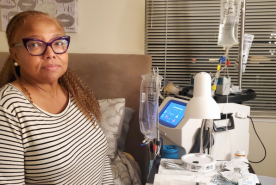Last Updated: September 16, 2024
Medically reviewed by NKF Patient Education Team
About GLP-1 Receptor Agonists (GLP-1 RAs)
GLP-1 receptor agonists (GLP-1 RAs) are a type of prescription medicine commonly recommended for people with type 2 diabetes and/or obesity. Combined with healthy eating habits and physical activity, GLP-1 RAs can help you keep your blood sugar levels in the goal range and lose weight (if needed). For people living with chronic kidney disease (CKD) or at risk for CKD, this means GLP-1 RAs can help slow down the CKD disease process by addressing these two risk factors. New research suggests GLP-1 RAs may also have a direct effect on helping the kidneys stay healthy.
People living with CKD are at an increased risk of heart attack or stroke, also known as cardiovascular disease (CVD). Most GLP-1 RAs have been shown in clinical trials to help lower the risk of CVD, offering another benefit for people living with CKD.
Uses
GLP-1 RAs are approved by the United States Food and Drug Administration (FDA) to treat adults with type 2 diabetes. A few GLP-1 RAs have also been approved to treat adults with obesity. Some GLP-1RAs are also approved for use in children as young as 12 years of age who are living with type 2 diabetes and/or obesity.
Current guidelines recommend a long-acting GLP-1 RA for adults living with type 2 diabetes and CKD who have not yet reached their diabetes goals with metformin and an SGLT2 inhibitor.
How They Work
GLP-1 stands for “glucagon-like peptide-1”. GLP-1 is a hormone (a natural chemical messenger or signal) that your small intestine naturally makes in response to meals. Hormones are a part of your body’s messenger service, sending messages to and from different parts of your body to keep things running smoothly.
The four main messages that GLP-1 sends to other parts of your body include:
- Telling your pancreas to release insulin to help digest meals
- Telling your liver to slow the release of stored sugars (to keep blood sugar from going too high)
- Slowing down how quickly food leaves your stomach to increase digestion
- Increasing the signals to your brain that let you know when you are full (also known as satiety)
The GLP-1 RAs are medicines designed to work like the GLP-1 hormone your body naturally makes and help to amplify (increase) its effects.
The direct effects of GLP-1 RAs on improving kidney health are not fully known. Leading research suggests they may also help with lowering inflammation in the kidney and/or removing extra sodium from the body, but more research is needed to know for sure. Studies have also shown that GLP-1 RAs help decrease urine albumin-creatinine ratio (uACR) levels for people with albuminuria, though not as much as SGLT2 inhibitors, ACE inhibitors/ARBs, or nsMRAs.
Types
There are many types of GLP-1 RAs available today, with more undergoing clinical trials. The main differences between them include how you take them (by injection or by mouth), how often you take them, and in which disease state(s) they were directly studied (type 2 diabetes or obesity).
Short-acting GLP-1 RAs that are taken every day include:
- Exenatide (Byetta): twice-daily injection
- Liraglutide
- Victoza (for type 2 diabetes): once-daily injection
- Saxenda (higher doses for obesity): once-daily injection
- Victoza (for type 2 diabetes): once-daily injection
- Semaglutide (Rybelsus): once-daily tablet (taken by mouth)
Long-acting GLP-1 RAs that are taken once weekly include:
- Dulaglutide (Trulicity)
- Exenatide extended-release (Bydureon)
- Semaglutide
- Ozempic (for type 2 diabetes)
- Wegovy (higher doses for obesity)
- Ozempic (for type 2 diabetes)
- Tirzepatide*
- Mounjaro (for type 2 diabetes)
- Zepbound (higher doses for obesity)
- Mounjaro (for type 2 diabetes)
*In addition to increasing GLP-1 activity, tirzepatide also increases GIP, another hormone that is very similar. While technically considered a “dual GIP/GLP-1 RA”, it has many of the same effects as the other GLP-1 RAs.
Effectiveness
GLP-1 RAs offer many health benefits including improved blood glucose (sugar) and A1C levels and weight loss. Some GLP-1 RAs have also been shown in clinical trials to lower the risk of heart attack or stroke.
A major clinical trial studying the effects of once weekly semaglutide on kidney health for people living with type 2 diabetes found once weekly semaglutide helped slow the CKD disease process and lowered the risk of developing kidney failure. People taking semaglutide group also had a lower risk of dying from kidney disease or cardiovascular disease. This is the first major study looking directly at the effect of GLP-1 RAs on CKD. Similar trials with other GLP-1 RAs are ongoing, including in people with CKD and obesity without type 2 diabetes.
Be sure to tell your healthcare professional about any side effects you might be having and work together to find a solution. Do not adjust your dose without talking to your healthcare professional first.
Additional considerations
Pregnancy
GLP-1 RAs are not recommended during pregnancy. Animal studies have shown risks of harm to the baby, and there are limited data in pregnant women. If it is possible for you to become pregnant, plan to use an effective and reliable form of birth control while taking a GLP-1 RA.
Talk to your healthcare professional as soon as possible if you are pregnant or planning to become pregnant. This is especially true for the long-acting (once weekly) GLP-1 RAs as they can take several weeks to be fully removed from your body.
Questions for your healthcare team
- Should I be considering a GLP-1 RA for my CKD and other health conditions?
- Is there one GLP-1 RA that might be a better fit for me than the others based on my preferences and other medical conditions?
- Am I at a higher risk for any of the side effects caused by GLP-1 RAs?
- [If you are having side effects:] What can I do to help these side effects go away?
- How will I know if this GLP-1 RA is working for me?








